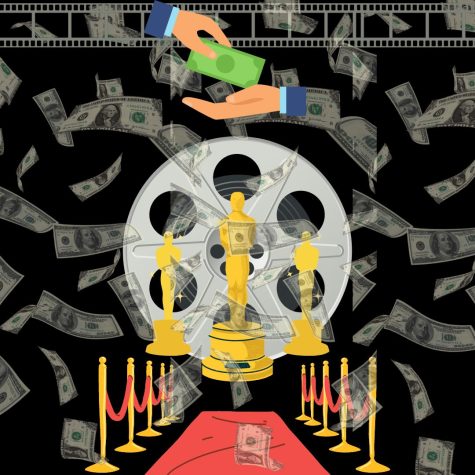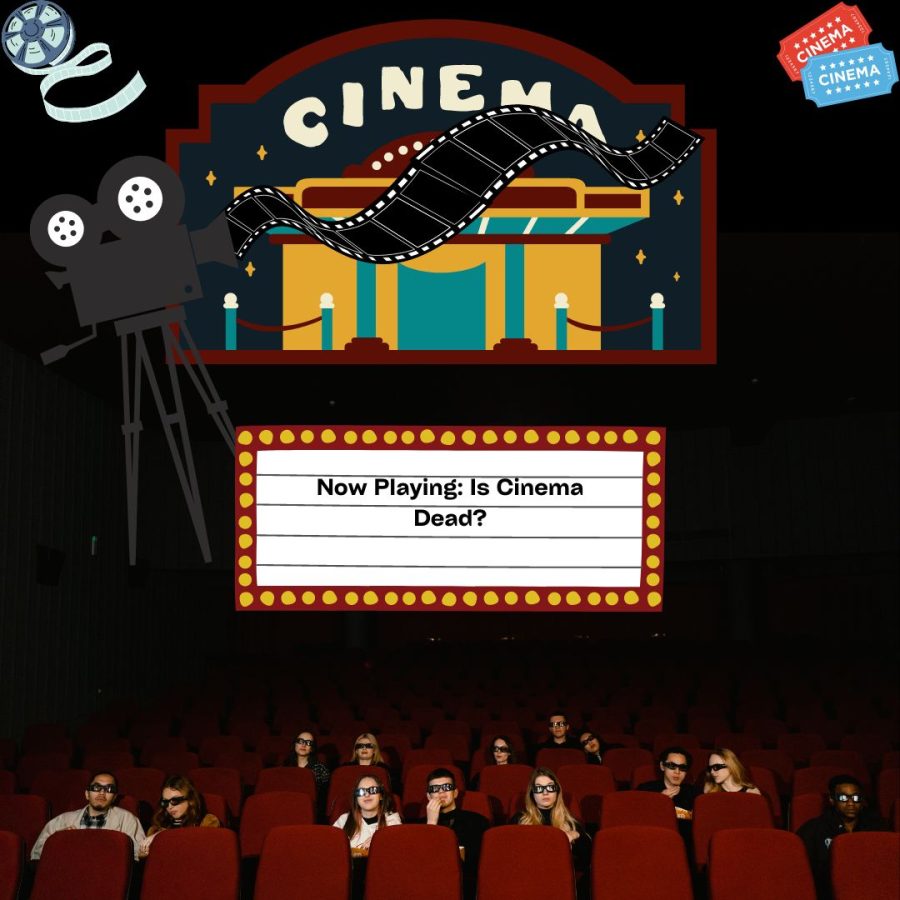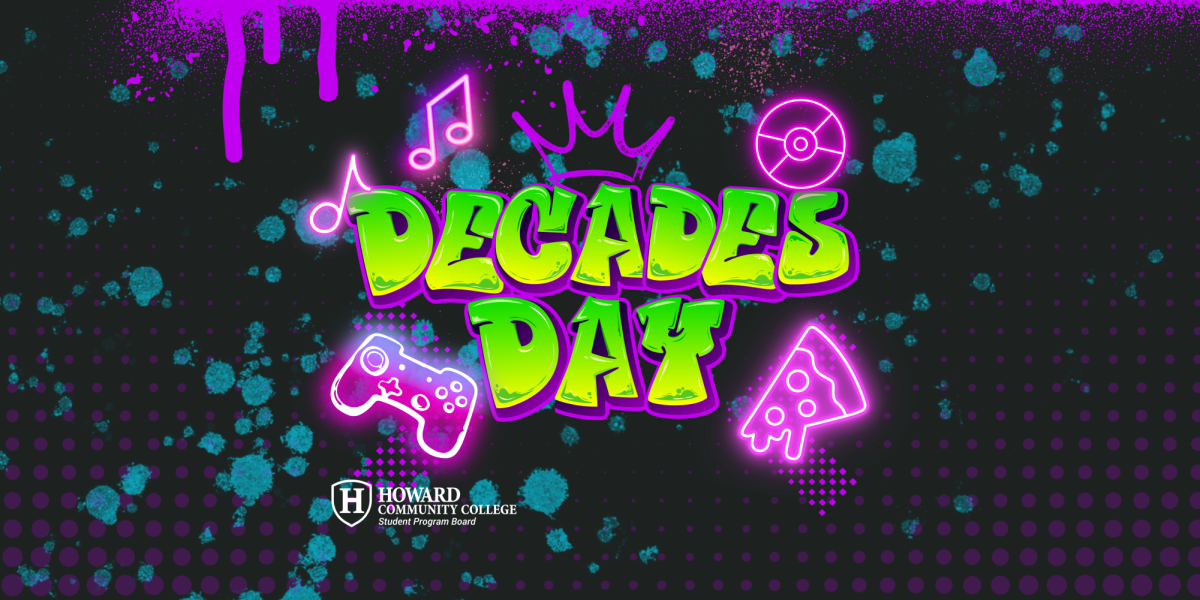Is Cinema Dead?
A custom digital graphic depicting people seated in a cinema
May 2, 2023
It’s another boring Friday night. With no plans whatsoever I decide to head to my local theater and hope for something to keep me entertained.
Walking inside the theatre I stare at the giant digital screen displaying all the movies being shown. A wave of disappointment washes over me as I scan through the listings. “Avengers 78: Captain America Reborn Again Part 2,” “Scream 25: The Re-Re-Return of Ghostface,” “Frozen (Live-Action Remake),” “Indiana Jones 9: The Death of Indiana Jones? (He Won’t Die),” “Spiderman 15: Aunt May’s Return as Spider Aunt” and “Jurassic Park 32: The Re-Re-Re-Re-Re-Re Opening.”
Those movies may not be real now, but I wouldn’t rule out the possibility. We’ve all had similar experiences at the theaters in recent years.
Do you remember walking down the dimly lit hallways, sitting at the cushiony seats and grabbing a handful of popcorn as you wait in excitement for the movie to begin? Over the past few years, however, that feeling no longer exists.
Modern-day cinema is a former shell of itself. For years now, entertainment quality has been steadily declining without signs of improvement.
Redundant sequels, pointless live-action remakes and oversaturation of superhero movies amongst other reasons have led to the death of cinema as we know it. Unoriginality is a plague that has not only affected the film industry but also filled the pockets of those who profit from it.
Profit has always been in the minds of producers and film company executives for decades now. However, there was always a strive to be original, to find something that will completely captivate the audience, while also reeling in boatloads of money.
Nowadays, we see the same needs for profit, but at a loss in uniqueness and innovation. Finding out what earns the most amount of money and oversaturating the living hell out of it has become the motto for company executives worldwide.
Having a sense of security that at least some hardcore fans will fill the theater even when a franchise has been metaphorically beating a dead horse for years now is more apparent than ever.
Quantity over quality is the new standard for cinema. The big ballers in the industry like Disney and Warner Brothers who own rights to hundreds of stories now continue to release films each year based on franchises way past their expiration date.
Unnecessary sequels are the biggest problem for modern cinema. While I’m not against two or three sequels for a movie, there has to be a line drawn between creativity and generating profit. The minute a certain movie gets some amount of attention, studios flock to create the next one in the series.
Pushing deadlines and destroying perfect stories all for some extra cash is an issue Hollywood grapples with. There’s a reason 10/10 films like “Interstellar,” “Pulp Fiction,” “The Grand Budapest Hotel” and “The Sixth Sense” never had sequels. The story was perfectly encapsulated and most importantly completed in that amount of time. Whatever occurred next is purely up to the audience to decide. The film’s reputation wasn’t tainted by sequels creating more and more scenarios.

Highly skilled directors like Quentin Tarantino, Martin Scorsese and Christopher Nolan have abilities to make every movie their own, sometimes with more power over big studios.
Smaller directors, however, are offered contracts and deals to make multiple movies, often making what was once a project of love and admiration just work. Sequelizing movies has only led to more stories being stretched out further than needed to generate as much revenue as possible.
Disney is well known for its excellent films that resided with children and adults all across the globe. However, Disney’s recent live-action remake trend relies on pure nostalgia. Instead of constructing something new, Disney decides to dig up old fan favorites and “revitalize” them. The magic and awe we experienced as kids watching films like “Dumbo” and “Pinnochio” were things that could only be felt from the illustrious animation, and enjoyment of a time past.
Companies that recognized they cannot simply re-release films to make money turned to live-action instead. These films take the original story—which could only be told through magical animation years ago, captured by artists and animators who put their heart and soul into the project—and destroy it.
The film is repackaged but without the spirit of its original release. “Dumbo,” “Mulan” and “Pinnochio” are the latest of the live-action curse to be poorly received by many. These films hold heavy weight, not only because they ruined something great, but because they did it to make a quick buck.
Yes! Another superhero movie release, I hope this one will be different from thousands of others released prior, right? No. Well maybe there’ll be a compelling story with a villain that has characteristics beyond being the villain at least? No again.
The superhero genre has become so oversaturated that it’s actually difficult to not find a superhero movie playing at your local theatre. Whether it be Marvel, DC or some other company hoping to cash in on the superhero craze, the quality of films have become worse and worse.
When the first Avengers movie hit theatres over a decade ago, the genre was fresh, new and exciting. It was a team-up that would change the lives of many but also change the entire ecosystem of the film industry in the process. While a superhero movie now and then would be great to have, the releases have only become more frequent. On top of that, there are more shows released that have now become required to fully understand the newest films.
While there are certain exceptions to the superhero genre like 2019’s “Joker” and 2022’s “The Batman” which both used a gritty dark tone, differing from today’s standard, most of the superhero films follow the same boring formula.
Taking a look at upcoming releases this year we can see an overabundance of sequels, live-action movies and superhero movies. The 2023 list includes “Transformers: Rise of the Beasts,” “Wonka,” “Indiana Jones and the Dial of Destiny,” “The Little Mermaid,” “Fast and Furious 10,” “Peter Pan and Wendy,” “Insidious: The Red Door,” “The Nun 2,” “The Hunger Games: The Ballad of Songbirds and Snakes,” “Scream 6,” “Saw X,” “The Meg 2,” etc. I’m not even naming all the superhero movies because in total there are seven coming out just this year. That’s insane.
Conjuring up the most amount of money seems to be the top priority for studio executives. With less of a focus on art and more on profit, we see a distinct decline in the creativity of films.
As the years continue, the characteristics that made cinema popular will dwindle, and the innovativeness that set us apart will diminish. Without taking risks it’ll be harder to create something fresh and unique. With cinema’s reputation on the line, a change must be made to reverse the downward spiral that is the film industry.








